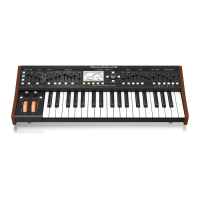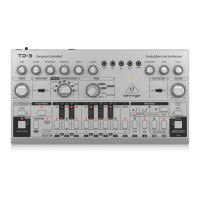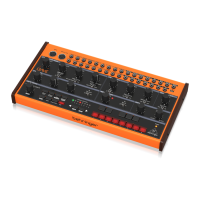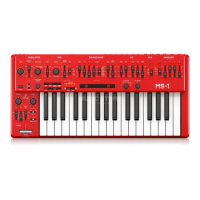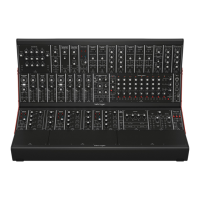43 DeepMind 12 User Manual
PEG MODES - Above and below the keyboard illustration are small "pegs" that
show the keys that are notes (N) of an existing poly chord, and the keys that are
triggers (T).
• N – An "N" in the top left indicates that the last key pressed has a poly chord
bound to it (trigger key). The notes of that poly chord will be shown with
pegs above and below the keyboard:
• T – A "T" in the top left indicates that the last key pressed was a blank
(non-trigger) key. The currently-assigned trigger keys in this bank will be
shown with pegs above and below the keyboard as shown:
POLY CHORD DISPLAY (LOWER SECTION) - The lower half of the poly chord
screen represents a two-octave wide section of the keyboard, centered about the
last key pressed (and represented by the brackets on the top section). The last key
pressed (or triggered externally) is shown with a highlighted box showing the
current note name and OCT number (such as G5 in this example).
• Shaded keys indicate those which are currently out of range of the current
keyboard settings. Unshaded keys are those which are currently available on
the physical keyboard.
Note: On the LOCAL keyboard, the Trigger keys are independent of the OCT
setting, they are tied to the physical key when set up as a trigger. For example,
if the last key on the left is set up to trigger a poly chord of F2 + A2 + C3, then
if you now press OCT up 1 octave, the last key on the left will still play this same
poly chord F2 + A2 + C3.
KEYBOARD NAVIGATION
• Pressing the -/NO or +/YES physical switches to the right of the display, will
move the display backwards and forwards through all available keys. If a
trigger is available in the direction of navigation, the displayed keyboard will
jump straight to that key (with a T on it). If no trigger is available, it will scroll
by, one key at a time.
• The rotary knob will also move backwards and forwards through all available
keys, jumping to a trigger key if available, in the direction of travel.
• Use the DATA ENTRY fader to move the view of the keyboard without
jumping to the next available trigger. As a guide, watch the brackets above
the top keyboard move as you move the fader, rotary knob, or -/NO or +/YES
switches.
TRIGGER TYPES
• T – The letter T is shown printed on all trigger keys.
• E – The letter E indicates that the poly chord is assigned to a xed MIDI
note trigger (E = external). The absence of an E indicates that the chord is
triggered by the local keyboard.
• The display below shows a local keyboard trigger on A3 with notes on F2, F3,
A3, and C4. The small dots on the keys show the notes in the selected chord:
STATUS SECTION - The status section at the bottom of the poly chord page
shows a variety of information about the recording state, the current soft switch
status, and information about either the selected chord (if the last key pressed
was a trigger), or the current bank and the total used space.
• The example below shows a Major chord (Ma) with a modier of "Spread2"
and composed of notes F2, F3, A3, and C4, with the external trigger at A3.
• The example below shows the status section of a non-trigger key:
POLY CHORD SCREEN SOFT KEYS - At the bottom of the poly chord page are ve
labels which indicate the software function of the ve illuminated switches just
below: PROG, FX, GLOBAL, COMPARE and WRITE.
• This example shows the soft switches when a key with a trigger is selected.
Note that DEL allows you to delete the current trigger, and VIEW shows more
details.
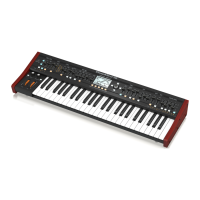
